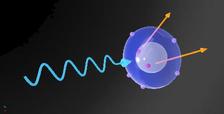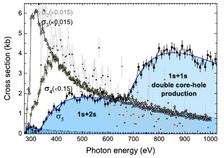Multiple ionisation of an carbon anion (Credit: A. Borovik Jr.).
Negatively charged atomic ions are highly correlated atomic systems in which the extra electron is only weakly bound to the neutral atomic shell. Some types of atoms, such as nitrogen, cannot form stable anions at all. Anions are therefore ideally suited for studying correlation effects which are relevant for the theoretical description and the understanding of e.g. the chemistry of atoms and molecules.
The interaction between electrons in a quantum system manifests itself particularly when one or both electrons are released from the innermost shell, the K-shell of the atom. After generation of holes in the K-shell, the atomic system relaxes by cascades of Auger and radiative transitions remains. Depending on the path of the cascade, further electrons are emitted and an ion with multiple positive charges and different charge states. The complex dynamics that sets in after single or double core hole creation in carbon anions was measured at DESY by using the ‘Photon-ion spectrometer at the PETRA III’ (PIPE) end station at beamline P04 for experiments in the soft X-ray (XUV) range.
The experimental challenge in studying the photon-ion interaction is that negative ions can only be prepared as a very dilute target with very low particle densities which are comparable to the residual gas density in an ultra-high vacuum. To measure these low-target densities a high photon flux, a long interaction region, and high detection efficiency is needed. In the PIPE apparatus, a magnetic mass-analysed beam from an ion source was collinearly superimposed with the XUV photon beam, resulting in an interaction path of up to about 1.5 m length. The heavy and charged reaction products generated by the photon-ion interaction were magnetically separated from the primary ion beam and detected in a special single-particle detector with almost 100% efficiency. For carbon anions, the absolute probabilities for the generation of positively charged Cq+ ions with charge states q=1, 2, 3 and 4 as a function of photon energy could thus be determined experimentally.
Depending on the photon energy, the production of C1+ is up to 10,000 times more probable than the production of C4+. These sensitive measurements were only possible due to the high photon flux at beamline P04 and the very high measurement sensitivity of the PIPE apparatus. Moreover, it was possible to detect a unique signature for the generation of double-K hole states in carbon anions caused by interaction with only one photon in the C4+ channel.
Double K-hole states in atoms and molecules are currently also studied intensively at free-electron lasers (FEL) like the European XFEL. These states play a special role in the transparency of plasmas for X-rays and they can be used for time-resolved tracking of the dynamics of photoinduced break of molecule bonds. Furthermore, the measured absorption spectra of carbon anions could also be useful for the detection of ions in interstellar gas clouds. So far only negatively charged carbon compounds but no atomic carbon anions have been observed.
The experiments were performed within the framework of the BMBF ‘Verbundforschung’ and with funding from the DFG. S. Schippers lead the research team from the following institutions: Justus Liebig University Giessen, Universität Hamburg, Friedrich Schiller University Jena, Helmholtz Institut Jena, Fritz Haber Institut Berlin, ATOMKI (Hungary) and DESY.
Original publication:
Multiple photodetachment of carbon anions via single and double core-hole creation; A. Perry-Sassmannshausen, T. Buhr, A. Borovik Jr., M. Martins, S. Reinwardt, S. Ricz, S. O. Stock, F. Trinter, A. Müller, S. Fritzsche, and S. Schippers; Physical Review Letters, 2020; DOI: 10.1103/PhysRevLett.124.083203 (PRL Editors' Suggestion).








